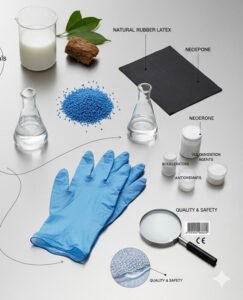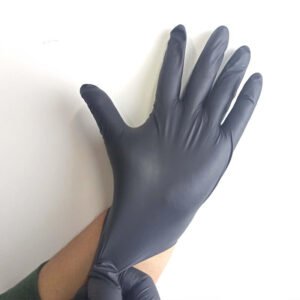What Are the Raw Materials for Surgical Gloves? A Comprehensive Guide
Table of Contents
1. Introduction to Surgical Glove Materials
Surgical gloves serve as a critical barrier between healthcare professionals and patients, preventing the transmission of pathogens and protecting against chemical exposure. The choice of raw materials directly impacts the glove’s performance characteristics, including flexibility, tactile sensitivity, barrier protection, and biocompatibility.
Modern surgical gloves are manufactured from either natural or synthetic rubber materials, each offering distinct advantages and limitations. Understanding these materials is essential for healthcare facilities to make informed procurement decisions and for manufacturers to develop products that meet stringent medical standards.

2. Natural Rubber Latex
2.1 Source and Extraction
Natural rubber latex is derived from the Hevea brasiliensis tree, commonly known as the rubber tree. The latex is harvested through a process called “tapping,” where incisions are made in the bark to collect the milky sap that flows out.
Key Characteristics of Natural Latex:
- Botanical origin: Hevea brasiliensis trees
- Primary component: Polyisoprene (cis-1,4-polyisoprene)
- Typical solids content: 30-35%
- pH range: 6.5-7.0
2.2 Properties and Advantages
Natural rubber latex offers several superior properties that make it ideal for surgical glove manufacturing:
- Exceptional Elasticity: Natural latex provides outstanding stretch and recovery properties, allowing for comfortable fit and movement.
- Superior Tactile Sensitivity: The thin films achievable with latex offer excellent dexterity and touch sensitivity.
- High Tensile Strength: Latex gloves demonstrate excellent resistance to tearing and puncturing.
- Excellent Barrier Properties: Provides effective protection against bloodborne pathogens and chemicals.
2.3 Limitations and Concerns
Despite its advantages, natural latex has significant limitations:
- Allergenic Proteins: Contains proteins that can cause Type I allergic reactions
- Chemical Sensitivity: Limited resistance to oils, greases, and certain chemicals
- Degradation: Susceptible to ozone, UV light, and elevated temperatures
3. Synthetic Materials
3.1 Nitrile Rubber (NBR)
Acrylonitrile-butadiene rubber (NBR) has become increasingly popular for surgical glove manufacturing due to its excellent chemical resistance and latex-free composition.
Nitrile Rubber Composition:
| Component | Percentage Range | Function |
|---|---|---|
| Acrylonitrile | 15-50% | Chemical resistance, strength |
| Butadiene | 50-85% | Flexibility, elasticity |
Advantages of nitrile rubber include superior puncture resistance, excellent chemical compatibility, and absence of latex proteins. However, it typically offers less elasticity than natural latex and may have reduced tactile sensitivity.
3.2 Neoprene (Polychloroprene)
Neoprene surgical gloves offer a balance between the properties of latex and nitrile materials. This synthetic rubber provides:
- Good chemical resistance
- Moderate flexibility and comfort
- Latex-free composition
- Reasonable cost-effectiveness
3.3 Synthetic Polyisoprene
Synthetic polyisoprene closely mimics the molecular structure of natural rubber latex while eliminating the allergenic proteins. This material offers:
- Similar feel and performance to natural latex
- Protein-free composition
- Excellent elasticity and tactile sensitivity
- Lower allergenic potential
4. Additives and Processing Chemicals
4.1 Vulcanization Agents
Vulcanization is crucial for converting raw rubber into a durable, elastic material. Common vulcanizing agents include:
- Sulfur: Traditional vulcanizing agent providing crosslinks between polymer chains
- Zinc oxide: Acts as an activator and reinforcing agent
- Peroxides: Alternative vulcanizing system for certain applications
4.2 Accelerators and Activators
These chemicals speed up the vulcanization process and improve efficiency:
Common Accelerators:
- Thiazole derivatives: Mercaptobenzothiazole (MBT), Benzothiazyl disulfide (MBTS)
- Thiuram compounds: Tetramethylthiuram disulfide (TMTD)
- Dithiocarbamate compounds: Zinc diethyldithiocarbamate (ZDEC)
4.3 Antioxidants and Stabilizers
These additives protect the rubber from degradation during processing and use:
- Primary antioxidants: Prevent chain scission and crosslinking
- Secondary antioxidants: Decompose hydroperoxides formed during oxidation
- UV stabilizers: Protect against photodegradation
5. Surface Treatments and Coatings
Surface treatments enhance glove performance and user comfort:
- Powder coating: Traditionally cornstarch or talc (now largely phased out)
- Polymer coatings: Hydrogel or silicone treatments for easy donning
- Chlorination: Surface treatment to reduce tackiness and protein content
- Antimicrobial treatments: Silver ions or other biocides for enhanced protection
6. Quality and Safety Considerations
Raw material selection must consider several critical factors:
Key Quality Parameters:
- Biocompatibility: Materials must not cause adverse biological reactions
- Protein content: Especially important for latex materials
- Chemical extractables: Residual chemicals that might leach from the glove
- Physical properties: Tensile strength, elongation, and modulus
- Barrier effectiveness: Resistance to viral and bacterial penetration
Regulatory compliance requires adherence to standards such as ASTM D3578, EN 455, and ISO 11193, which specify requirements for materials, performance, and biocompatibility testing.

7. Conclusion
The raw materials used in surgical glove manufacturing have evolved significantly to meet the demanding requirements of modern healthcare. While natural rubber latex remains the gold standard for many applications due to its superior elasticity and tactile properties, synthetic alternatives like nitrile, neoprene, and synthetic polyisoprene offer important advantages, particularly in addressing latex allergy concerns.
The selection of appropriate raw materials involves balancing multiple factors including performance characteristics, safety considerations, cost-effectiveness, and regulatory compliance. As healthcare needs continue to evolve, ongoing research and development in raw materials will drive innovations in surgical glove technology, ensuring that these critical protective devices continue to provide optimal safety and performance for healthcare professionals and patients alike.
Understanding these raw materials enables informed decision-making in glove selection and highlights the complex chemistry behind these seemingly simple but essential medical devices.
